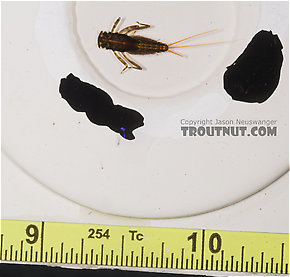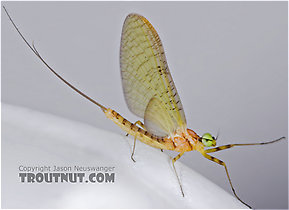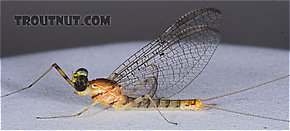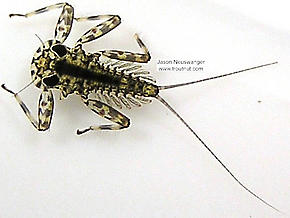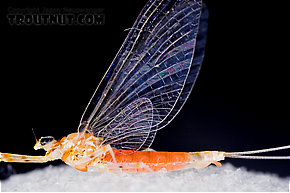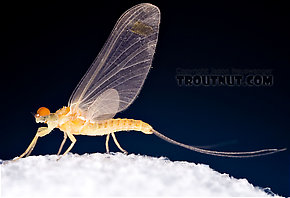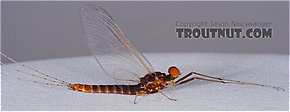Blog & Latest Updates
Fly Fishing Articles
Insects by Common Name


Light Cahills
Scientific Names
Like most common names, "Light Cahill" can refer to more than one taxon. They're previewed below, along with 11 specimens. For more detail click through to the scientific names.
Mayfly Genus Stenacron
These are pretty much always called Light Cahills.
The species in this genus were formerly classified in Stenonema. See the genus Maccaffertium for details. Only one species, Stenacron interpunctatum, is important to fly fishermen. See its page for details.
See 5 more specimens...
Mayfly Species Maccaffertium ithaca
These are often called Light Cahills.
Maccaffertium ithaca (Light Cahill) Mayfly Nymph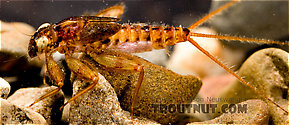 View 9 PicturesThis specimen seems to be of the same species as a dun I photographed which emerged from another nymph in the same sample.
View 9 PicturesThis specimen seems to be of the same species as a dun I photographed which emerged from another nymph in the same sample.
 View 9 PicturesThis specimen seems to be of the same species as a dun I photographed which emerged from another nymph in the same sample.
View 9 PicturesThis specimen seems to be of the same species as a dun I photographed which emerged from another nymph in the same sample.Female Maccaffertium ithaca (Light Cahill) Mayfly Dun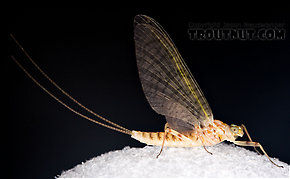 View 10 PicturesThis female looks very much like a male I collected a few hundred miles away a few days later, so I'm guessing it's the same species, which I believe is Maccaffertium mediopunctatum.
View 10 PicturesThis female looks very much like a male I collected a few hundred miles away a few days later, so I'm guessing it's the same species, which I believe is Maccaffertium mediopunctatum.
 View 10 PicturesThis female looks very much like a male I collected a few hundred miles away a few days later, so I'm guessing it's the same species, which I believe is Maccaffertium mediopunctatum.
View 10 PicturesThis female looks very much like a male I collected a few hundred miles away a few days later, so I'm guessing it's the same species, which I believe is Maccaffertium mediopunctatum.See 2 more specimens...
Mayfly Species Maccaffertium pulchellum
These are often called Light Cahills.
Mayfly Species Cinygma dimicki
These are sometimes called Light Cahills.
Mayfly Species Epeorus vitreus
These are sometimes called Light Cahills.
This is the second most common Epeorus species in the East and Midwest. Most anglers will encounter sporadic hatches of Epeorus vitreus once in a while, and sometimes a more concentrated emergence causes a good rise of fish.
Male Epeorus vitreus (Sulphur) Mayfly Dun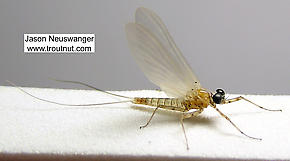 View 4 PicturesThis is my favorite mayfly from 2004, and it appears on my popular Be the Trout: Eat Mayflies products. Check them out!
View 4 PicturesThis is my favorite mayfly from 2004, and it appears on my popular Be the Trout: Eat Mayflies products. Check them out!
Its identification is really up in the air. It might be a late-season vitreus dun but it may very well be one of the more obscure species in that genus.
 View 4 PicturesThis is my favorite mayfly from 2004, and it appears on my popular Be the Trout: Eat Mayflies products. Check them out!
View 4 PicturesThis is my favorite mayfly from 2004, and it appears on my popular Be the Trout: Eat Mayflies products. Check them out!Its identification is really up in the air. It might be a late-season vitreus dun but it may very well be one of the more obscure species in that genus.
See 12 more specimens...
Mayfly Species Ephemerella invaria
These are very rarely called Light Cahills.
This species, the primary "Sulphur" hatch, stirs many feelings in the angler. There is nostalgia for days when everything clicked and large, selective trout were brought to hand. There is the bewildering memory of towering clouds of spinners which promise great fishing and then vanish back into the aspens as night falls. There is frustration from the maddening selectivity with which trout approach the emerging duns--a vexing challenge that, for some of us, is the source of our excitement when Sulphur time rolls around.
Ephemerella invaria is one of the two species frequently known as Sulphurs (the other is Ephemerella dorothea). There used to be a third, Ephemerella rotunda, but entomologists recently discovered that invaria and rotunda are a single species with an incredible range of individual variation. This variation and the similarity to the also variable dorothea make telling them apart exceptionally tricky.
As the combination of two already prolific species, this has become the most abundant of all mayfly species in Eastern and Midwestern trout streams.
Ephemerella invaria is one of the two species frequently known as Sulphurs (the other is Ephemerella dorothea). There used to be a third, Ephemerella rotunda, but entomologists recently discovered that invaria and rotunda are a single species with an incredible range of individual variation. This variation and the similarity to the also variable dorothea make telling them apart exceptionally tricky.
As the combination of two already prolific species, this has become the most abundant of all mayfly species in Eastern and Midwestern trout streams.
Ephemerella invaria (Sulphur Dun) Mayfly Nymph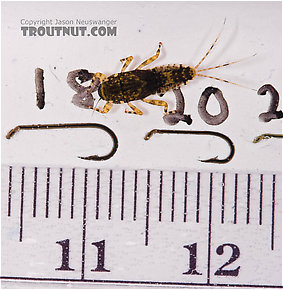 View 8 PicturesThis small Ephemerella invaria nymph was at least a month away from emergence.
View 8 PicturesThis small Ephemerella invaria nymph was at least a month away from emergence.
 View 8 PicturesThis small Ephemerella invaria nymph was at least a month away from emergence.
View 8 PicturesThis small Ephemerella invaria nymph was at least a month away from emergence.See 42 more specimens...
Top 10 Fly Hatches
Top Gift Shop Designs
Eat mayflies.
Top Insect Specimens
Miscellaneous Sites
Troutnut.com is copyright © 2004-2024 Jason
Neuswanger (email Jason). See my FAQ for information about use of my images.
 privacy policy
privacy policy

